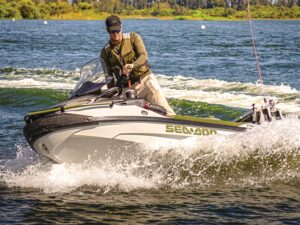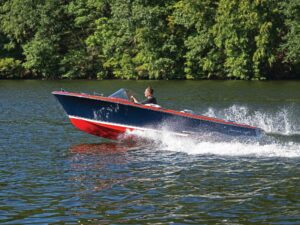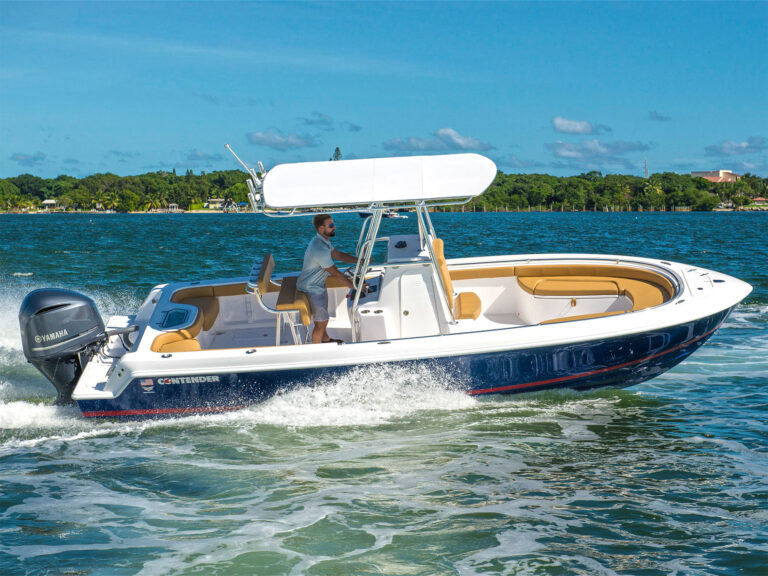Life is full of “truths” that are false. Wait an hour after you eat before swimming or you’ll drown. Don’t go outside with wet hair or you’ll catch a cold. You’ll go blind if you…well, you get the picture. There’s a lot of well-intentioned information out there that’s just plain wrong. Yet, we still believe it. As boaters, we see this all the time: Stainless steel doesn’t rust (it does); you can trust NOAA weather (you can’t); and outboards need to be winterized (they don’t). But the one boating mistruth that is most off-target is that waterbikes are the worst environmental offenders on the water. They are eco-nasty disasters with an obnoxious exhaust tone, ooze pollution, harass wildlife, encourage irresponsible behavior, and generally reduce the quality of life. I’m sure you’ve heard it before.
But the truth is just the opposite. The modern waterbike is the cleanest, quietest, most eco-friendly choice on the water. We love ’em. They’re the best there is for getting out and exploring the wilds of nature. Here’s why, and how. Waterbikes have gotten a bad rap. One environmental group compared their exhaust emissions to the Exxon Valdez oil spill. A Minnesota legislator tried to pass off a chainsaw as a recording of their exhaust, and national parks across the country have closed their gates to them. Talk about an image problem. The reality, however, is far less scandalous. Once these very same opponents are forced to objectively consider the modern waterbike, most reluctantly admit that they are actually eco-friendly. Their emissions are now classified as “ultra low” by the strictest government agencies. Their exhaust noise is equal to, if not less than, that of some of the quietest vessels on the water. And, thanks to that enclosed jet pump, waterbikes do little of the underwater damage that their prop-spinning counterparts are capable of. Want proof? Here it is.
Consider the most touted slap against the waterbike, its so-called “dirty” emissions. Today, few if any are still being built with the dirty two-strokes of legend.
According to data provided by both the Environmental Protection Agency (EPA) and the stricter California Air Resources Board (carb), waterbike engine emissions have been reduced as much as 90 percent compared to similar machines produced less than a decade earlier. According to carb representatives, 30 percent of the 2007 model-year waterbike line has achieved carb’s vaunted Three Star “Ultra Low Emissions” certification, a degree of cleanliness not required until 2008. In fact, the engine that powers both Kawasaki’s STX-12 and 15F reached that milestone way back in 2003. Of the remaining models, every four-stroke meets or exceeds carb’s current Two Star designation. Manufacturers have even discovered ways to clean up the few remaining two-stroke models, such as Yamaha’s powerful GP1300R, with a combination of fuel injection and a catalytic converter. “Generally, the industry has complied with the regulation on schedule, both by switching to four-strokes and by using cleaner two-stroke engines,” explains Karen Caesar, information officer for carb. “Four-stroke waterbike engines are as clean as outboard and inboard/stern drive engines with similar engine sizes.”
That’s one myth demolished.
Sound of Silence
The modern-day waterbike has also undergone a similar reduction in noise. We’ll all agree, the first bikes were irritating, which led to that chainsaw-called-a-waterbike recording by Minnesota representative Kris Hasskamp (a gimmick that many political insiders cite as the nail in her career’s coffin). But the modern waterbike has been muffled to an almost cat-like purr. Industry representatives note an up to 70 percent reduction in engine sound-pressure levels has been achieved over the last 10 years by lowering not only the exhaust’s volume but its high-pitched tone as well. Using such features as multi-chambered and baffled resonators on the air intakes, noise-absorbing materials between the liner and hull, rubber padding to dampen driveline noise, and thicker crankcase walls, manufacturers have dramatically lessened noise. Modern hull designs, which now favor a larger, heavier three-passenger craft, have also contributed to the hush factor, keeping the boats in the water, not airborne, and lessening the sound of waves resonating against the hull.
The National Park Service (NPS) verifies these claims. During sound level testing conducted at Lake Powell’s Glen Canyon National Recreation Area, maximum waterbike sound levels were found to be lower than the maximum sound levels of other motorized vessels. Judged against the NPS’ standard, which is based on a reading of 82 dB-A at 82′, it found that sound readings for the average waterbike ranged from 68 to 76 dB-A; other motorized vessels were found to average in the neighborhood of 64 to 86 dB-A. Just take note the next time a waterbike passes by. With the latest generation of craft, it’s quite common to see them before you hear them.
Myth two blown out of the water.
Ask a Fish
Even with all this, waterbikes are still persona non grata in places where other boats roam free, such as the Everglades and its 100-mile-long Wilderness Waterway. Officials still hold on to the old image, even when marine biologists around them insist otherwise. For example, Florida’s renowned Mote Marine Laboratory depends on waterbikes for its stranded animal investigations program. “They’re quiet,” explains Mote Senior Scientist Nelio Barros. “If the animal is still alive, then we need to assess whether the situation needs human interaction. These craft are so quiet, they allow us to get close enough to make a judgment.”
Mote scientists also praise waterbikes for their ability to get into shallow water with little impact. “In our line of work, the sooner you get to the animal, the better,” continues Barros. “But there’s no way you can walk to, or get a big boat into, some of these shallow areas. A waterbike’s maneuverability makes it the perfect vessel to use in a situation like ours. I can’t say enough good things about them. They have come through for us in many different ways.”
Still think waterbikes harass wildlife? Consider the numerous studies to the contrary. The Florida Fish and Wildlife Conservation Commission found that waterbikes have no greater impact on waterfowl than other motorized boats. There are also no marine mammal injuries or fatalities that have been attributed to waterbikes. In fact, the Florida Department of Environmental Protection, Bureau of Protected Species Management reviewed 25 years of manatee mortality records and found no waterbike has ever been implicated in a manatee death or injury. And, despite ongoing contentions to the contrary, a test in the Florida Keys proved that when waterbikes are driven in line with manufacturer’s recommended guidelines, they don’t affect seagrass beds or water turbidity. Another myth down.
If you’re not getting it by now, here’s the buzz: Waterbikes are without a doubt Mother Nature’s favorite.
****Fact Checks****
So why were these squeaky clean waterbikes banned from the National Park System? It was the result of a lawsuit filed against the NPS by the environmental group Bluewater Network. One of the conditions of the settlement was that the service would conduct environmental impact studies of waterbikes at the individual parks.
The results may have been less compelling for news outlets bent on dirty laundry, but they proved far more interesting to those with an open mind. Each park concluded that waterbikes should be allowed back in. One by one, pristine riding areas such as Lake Mead National Recreation Area, Glen Canyon National Recreation Area (Lake Powell), Florida and Mississippi’s Gulf Island National Seashore, and Michigan’s Pictured Rocks National Lakeshore dropped their bans and once again welcomed waterbikes. In fact, not one park that completed an environmental study has opted to keep the ban in place. It’s time to face facts. With their low emissions, ultra-quiet operation, shallow draft, and shielded jet pumps, waterbikes are the ideal boat for getting back to nature.
Want to give it a try? You should.
To find out how it’s done, we went to Sam Thomas. His Discovery River Tours (770/493-1792; www.pwctours.com) has been taking folks on waterbike cruises of scenic rivers since 1993. No one knows more about rigging a waterbike for adventure touring than him.
So gear up, choose a spot on the map, then explore Mother Nature with a clear conscience. After all, you’ll be aboard her favorite boat. Continued next page…
Gear up: Part 1
There’s no shortage of accessories to make adventure eco-cruising easier, safer, and more comfortable.
Water Goggle. Sunglasses won’t cut it in the wind and spray. Oakley’s H2O goggle offers the protection of a scratch-resistant Lexan lens, in a style that will stay put while riding. Oakley H2O L Frame, $37 to $65; www.oakley.com.
Gloves. Keep those hands warm, and maintain a grip on the bars. Jet Pilot Full Finger Glove, $30; www.jetpilot.com.
Cell Phone Dry Bag.You won’t find many waterproof cell phones on the market. Protect what you have with a dry bag that lets you use the phone without removing it. Dry Pak Phone Case, $25; www.drypakcase.com.
Board Shirt. The protection of Lycra, with the comfortable cut of a T-shirt. Jet Pilot Boardshirt, $35; www.jetpilot.com.
Board Shorts. Board shorts offer cruising comfort, with an inner Lycra or neoprene liner that staves off the chafe of a long ride. Jet Pilot Boat Trip Rideshort, $60; www.jetpilot.com.
Water Shoes. Cruising requires a shoe that’s comfortable while you’re on your waterbike, walking on the beach, or back in the bush. Jet Pilot Reflex, $70; www.jetpilot.com.
Neoprene PFD. Neoprene PFDs conform to your body, making them more comfortable and adding a layer of insulation. Jet Pilot Cell Block, $130; www.jetpilot.com.
Rescue Whistle. Clips to your life vest, so it’s there when you need it. Dakine Rescue Whistle, $2.50; www.dakine.com.
Riding Jacket. A must-have for fending off the chill and spray, while letting out excess heat and moisture. Sea-Doo Riding Jacket, $199; www.seadoo.com.
Handheld GPS. Get a waterproof model and loads of spare batteries. Plenty out there, but we have a favorite. Garmin GPSMap 76, $190; www.garmin.com.
Hydration Pack. The handy bite valve allows you to hydrate on the fly, and the backpack style lets you pack a few extras. Dakine Shuttle, $50; www.dakine.com.
**Gear up Part 2: **Wind Screen****
The most valuable comfort-increasing accessory keeps you warm and dry without blocking your vision. A must-have.
PWSee Shield, $259; www.pwctours.com.
Cargo Rack. From gas cans to coolers, luggage to paddles, sometimes it’s best not to pack too light. AdventuRack, $389; www.pwctours.com.
Collapsible Paddle. No gas? A clogged intake? This will get you to shore. Select one with a bright orange blade that can be used as a signaling device. Jet Logic Telescoping Paddle, $22; www.jetlogic.com.
Electronics Mounts. Easily mount everything from a GPS to a video recorder aboard your waterbike. RAM Mount, $35 to $50; www.ram-mount.com.
Tiedown Straps. Keep all that gear where it belongs. Dakine Tie Down Strap, $20; www.dakine.com.
Wet/Dry Bag. Keep all that soggy gear away from your dry clothes. Wet compartments are sealed and won’t leak into surrounding dry compartments. Dakine Wet Dry Duffle, $60; www.dakine.com.
INTO THE WILD
There are plenty of places for the responsible waterbike enthusiast to view nature’s spectacle. Just remember, always keep a safe distance, and never harass wildlife. This is their turf…you’re just visiting.
Alligators_. Savannah River, Georgia_ This legendary river is classic old-time Georgia, with lazy waters surrounded by towering pines and stately cypress trees. It’s also chock full of gators. Look for them in the clearer backwaters or soaking up the sun along the shore or on sandbars.
Bottlenose Dolphin_. Gulf Coast_ A recent estimate put the number of bottlenose dolphin in the Gulf of Mexico at more than 67,000. What does this mean for you? Your chances are good for spotting one virtually anywhere east of Mobile Bay. Best bets are Florida’s Marco Island and the open waters of the Ten Thousand Islands.
** Great White Sharks.** Farallon Islands, California Ignore the theme from Jaws stuck in your brain. Thanks to humans, the Great White has nearly vanished. Your chances of seeing this rare breed are best between August and November when they feed on sea lions. Just keep your toes out of the water.
Seals.Gulf of Maine, Maine Five species – harbor, gray, hooded, ringed, and harp – call the waters between Cape Cod and Nova Scotia home. Only hardcore seal lovers can bear the harsh winter months to see the fluffy white harp babies. Instead, opt for harbor and gray seals around New Harbor, Maine, during the summer.
Turtles.Palm Beach, Florida More than 90 percent of loggerhead sea turtle nests are found along Florida’s Atlantic coast, a number that accounts for greater than one-third of their total population. Try a gentle cruise along Palm Beach during the peak months of June and July, and keep your eyes on the beach.
Whales. Monterey Bay, California Humpbacks and blue whales – the largest – are commonly seen between May and November. From December through April, look for gray whales, along with dolphin, seals, sea lions, leatherback turtles…maybe even a killer whale or the occasional basking shark.









